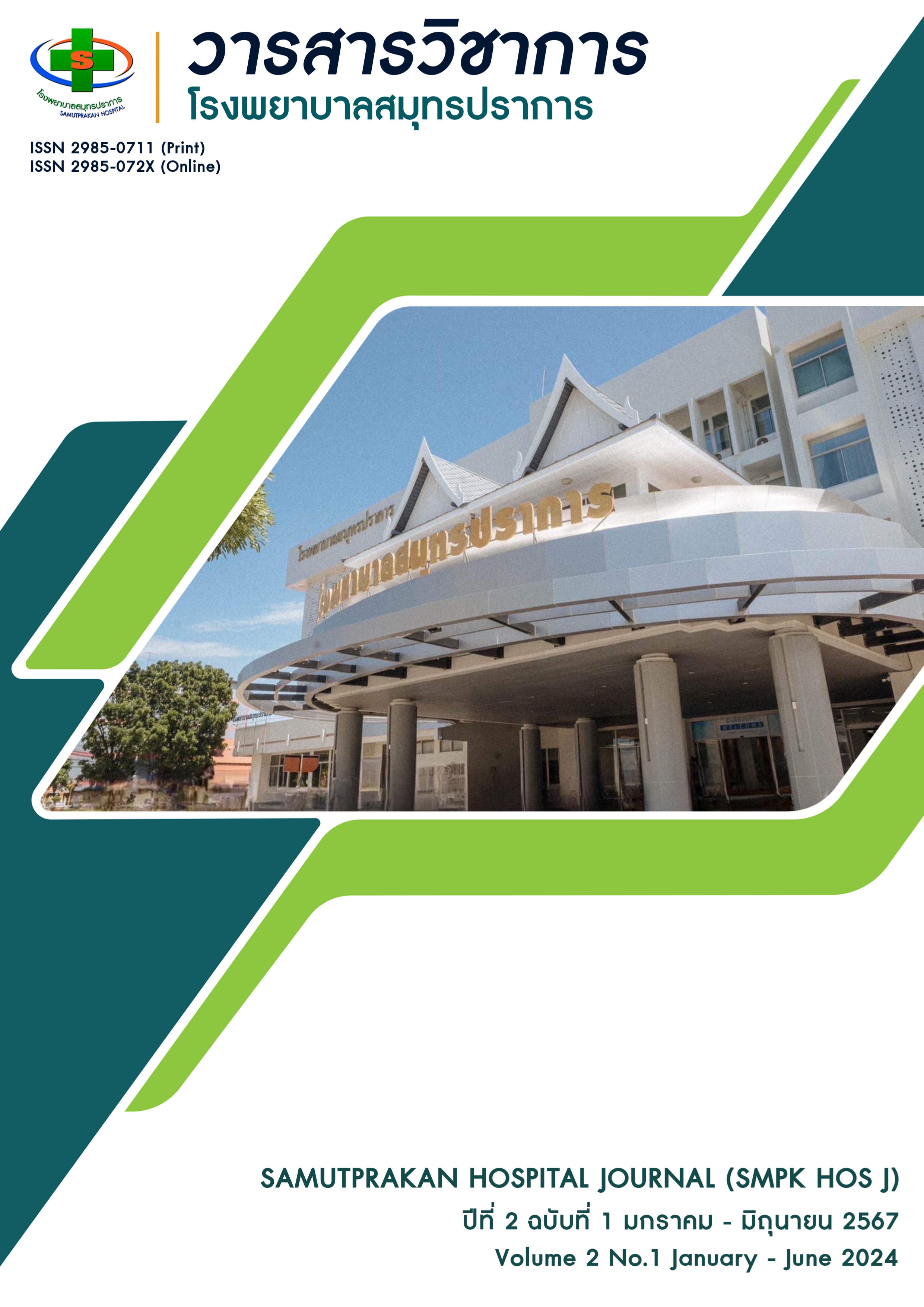Risk Factors for Sepsis in Stroke Patients at Samutprakan Hospital
Keywords:
sepsis, cerebrovascular disease, stroke, incidence rate, risk factorsAbstract
Cerebrovascular disease is a significant concern for hospitals worldwide, including in Thailand. Patients with this condition are at a relatively high risk for infections due to their vulnerability and extended hospital stays. Most deaths occur in hospitals rather than in the community, and infections complicate treatment, increasing the risk of mortality. This study aims to investigate the incidence rate of sepsis and identify associated risk factors in patients with cerebrovascular disease at Samutprakan Hospital.
This retrospective analytical study was conducted at Samutprakan Hospital from April 2018 to April 2022. The study examined sepsis risk factors and incidence rates in patients with cerebrovascular disease. A total of 250 purposive samples were selected. Data collection tools included records with personal information. The data were analyzed using descriptive statistics (means and percentages) and inferential statistics (Chi-square tests).
The study included 250 patients, of which 54.8% were male, with an average age of 65.92 ± 14.87 years. The average length of stay was 18.68 days. The analysis revealed a sepsis rate of 31.2% in patients with cerebrovascular disease. Significant risk factors for sepsis identified were: age: OR 0.81 (95% CI 0.65-1.20, p-value=0.003), alcohol consumption: OR 1.29 (95% CI 1.16-1.43, p-value=0.001), hypertension: OR 0.19 (95% CI 0.10-0.33, p-value=0.000), hyperlipidemia: OR 0.30 (95% CI 0.14-0.62, p-value=0.001), atrial fibrillation: OR 0.23 (95% CI 0.78-0.67, p-value=0.004), malnutrition: OR 4.52 (95% CI 1.96-10.40, p-value=0.000), endotracheal intubation: OR 0.35 (95% CI 0.18-0.67, p-value=0.001).
References
กลุ่มยุทธศาสตร์และแผนงานสำนักโรคไม่ติดต่อ กรมควบคุมโรค. แผนยุทธศาสตร์การป้องกันและควบคุมโรคไม่ติดต่อระดับชาติ 5 ปี (พ.ศ.2560-2564). กรุงเทพฯ; 2560.
Feigin VL, Brainin M, Norrving B, Martins S, Sacco RL, Hacke W, Fisher M, Pandian J, Lindsay P. World Stroke Organization (WSO): Global Stroke Fact Sheet 2022 [published correction appears. Int J Stroke. 2022;17(1):18-29.
นงพิมล นิมิตรอานันท์, ศศิธร รุจนเวช, จุฑารัตน์ ผู้พิทักษ์กุล. รูปแบบการสื่อสารความเสี่ยงทาง สุขภาพโรค หลอดเลือดสมองตามมิติวัฒนธรรมของกลุ่มชาติพันธุ์ไทยทรงดำ: กรณีศึกษาชุมชนหนึ่งในจังหวัด นครปฐม. วารสารคณะพยาบาลศาสตร์ มหาวิทยาลัยบูรพา. 2562; 27(2):80-92.
Rochmah TN, Rahmawati IT, Dahlui M, Budiarto W, Bilqis N. Economic Burden of Stroke Disease: A Systematic Review. Int J Environ Res Public Health. 2021;14(5):606–619.
กองโรคไม่ติดต่อ/สำนักสื่อสารความเสี่ยง กรมควบคุมโรค. กรมควบคุมโรค รณรงค์วันโรคหลอดเลือดสมองโลก หรือวันอัมพาตโลก 2565 เน้นสร้างความตระหนักรู้เกี่ยวกับสัญญาณเตือนโรคหลอดเลือดสมองให้กับประชาชน. 2565; วันที่ 28 ตุลาคม 2565.
มงคล สุริเมือง, ศรีสุดา อัศวพลังกูล. ลักษณะและผลกระทบของผู้ป่วยติดเชื้อในกระแสเลือดในโรงพยาบาลทั่วไป: กลุ่มงานวิจัยและพัฒนาการพยาบาล กลุ่มการพยาบาล โรงพยาบาลแม่สอด จังหวัดตาก. 2565.
Ngamjarus C, Chongsuvivatwong V. n4Studies: Sample Size Calculation for an Epidemiological Study on a Smart Device: Siriraj Med J. 2016;68(3):160-170.
Wang W, Jiang B, Sun H, Ru X. et.al. Prevalence, incidence, and mortality of stroke in china: results from a nationwide population-based survey of 480687 adults. Circulation. 2017;135(8):759-771.
Colbert JF, Traystman RJ, Poisson SN, Herson PS, Ginde AA. Sex-Related Differences in the Risk of Hospital-Acquired Sepsis and Pneumonia Post Acute Ischemic Stroke. J Stroke Cerebrovasc Dis. 2016;25(10):2399-404.
Liao CC, Shih CC, Yeh CC, Chang YC, Hu CJ, Lin JG, Chen TL. (2015). Impact of diabetes on stroke risk and outcomes: two nationwide retrospective cohort studies. Medicine (Baltimore). 2015; Dec; 94(52).
Bruening T, Al-Khaled M. Stroke-associated pneumonia in thrombolyzed patients: incidence and outcome. J Stroke Cerebrovasc Dis. 2015;24(8):1724–1729.
Boehme AK, Ranawat P, Luna J, Kamel H, Elkind MS. Risk of acute stroke after hospitalization for sepsis: a case-crossover study. Stroke. 2017;48(3):574–580.
Arero AG, Vasheghani-Farahani A, Tigabu BM, Ayene BY, Soltani D. Long-term risk and predictors of cerebrovascular events following sepsis hospitalization: A systematic review. Front Med (Lausanne). 2022; Nov 25; 9.
Ruangchaithaweesuk K, Watcharanurak P, Klubklay A. Factors influencing preventive behavior among stoke-risk patients in Songkhla province. The Southern College Network Journal of Nursing and Public Health, 2021;4(1):217-233.
Wastfelt M, Cao Y, Ström JO. Predictors of post-stroke fever and infections: a systematic review and meta-analysis. MC Neurol. 2018;18(1):49.
Chipp E, Milner CS, Blackburn AV. Sepsis in burns :A Review of current practice and future therapies. Ann Plas Surg 2010 ;65(2):228-36.
Pham TN, Kramer CB, Klein MB. Risk factors for the development of pneumonia in older adults with burn injury. J Burn Care Res 2010;31(1):105–10.
Castillo LL, Sumalapao DEP, Pascual JLR. Risk factors for pneumonia in acute stroke patients admitted to the Emergency Department of a Tertiary Government Hospital. Natl J physiol Pharm Pharmacol 2017;7(8):855-9.
Yeh SJ, Huang KY, Wang TG, Chen YC, et.al. Dysphagia screening decreases pneumonia in acute stroke patients admitted to the stroke intensive care unit. J Neurol Sci. 2011;306(1-2):38-41.
Downloads
Published
How to Cite
Issue
Section
License
Copyright (c) 2024 Samutprakan Hospital Journal (SMPK HOS J)

This work is licensed under a Creative Commons Attribution-NonCommercial-NoDerivatives 4.0 International License.







